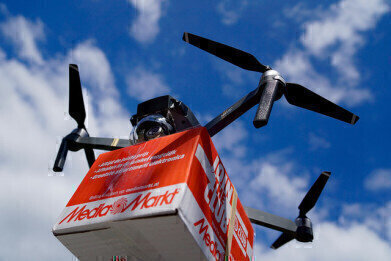Environmental Laboratory
How Does Drone Delivery Impact the Environment?
Jul 08 2018
The advent of drone technology has seen these flying contraptions infiltrate more and more facets of our daily lives. As well as being used as playthings of private citizens, they are also being deployed in a more environmental role, whether that be to monitor our coastlines or crack down on irresponsible methods of farming.
Additionally, they are also playing more of a role in the commercial sector, too. With companies like Amazon and DHL exploring drone technology to deliver parcels, they are not only improving their logistics but perhaps reducing their carbon footprint as well. After all, a tiny drone must consume less energy and emit fewer emissions than a HGV… mustn’t it?
Enterprising study from the US
New research from the Smithsonian in America attempted to quantify exactly that: how much, if any, environmental benefit is conferred by replacing truck delivery with drone delivery? To do so, the team (which was comprised of a mixture of researchers and scientists from universities across the United States) analysed all aspects of the energy consumption and pollution creation of both drones and HGVs and cross-referenced the results against one another.
For a more comprehensive overview, the team chose to assess the performance of one small quadcopter drone with the ability to carry a parcel weighing half a kilo, as well as another larger model capable of carrying up to 8kg in weight. Both drones were powered by lithium-based batteries due to the fact that the majority of drones in use favour this variety. The environmental cost of creating the battery was factored in, as was the cost of producing the energy to power it.
On the other side of the coin, the researchers looked at vehicles powered by all kinds of fuel, including diesel, petrol, natural gas and electricity. They counted not only the emissions produced by the vehicles while in use, but any emissions arising from the creation and powering of the batteries in the electric vehicles, as well.
A mixed bag of results
The results showed that the small drone was far more efficient than a large lorry or truck every single time, regardless of the fact that it could carry a much smaller payload and would therefore have to make far more trips. Truck delivery resulted in emissions of approximately 920g of greenhouse gases (GHGs) per parcel, while the drone could deliver the same package with just 420g of emissions, representing a 54% improvement.
On the other hand, larger drones were not as efficient as the smaller ones, and in some cases even less efficient than trucks. In places where the majority of electricity is not derived from renewables, such as Missouri, it was actually more beneficial for the environment to deliver a large package by truck than it was by drone.
All in all, it appears that fossil fuels and green energy must work hand in hand if optimum efficiency is to be achieved. While drones do have a positive impact on the environment for many deliveries, the good, old-fashioned method of truck delivery is eco-friendlier for larger parcels – at least for now. Until the technology develops further, delivery companies should use a mix of both kinds of transport to reduce their carbon footprint as much as possible.
Digital Edition
IET 34.2 March 2024
April 2024
Gas Detection - Biogas batch fermentation system for laboratory use with automatic gas analysis in real time Water/Wastewater - Upcycling sensors for sustainable nature management - Prist...
View all digital editions
Events
Apr 30 2024 Melbourne, Australia
Apr 30 2024 Birmingham, UK
May 03 2024 Seoul, South Korea
May 05 2024 Seville, Spain
May 06 2024 Minneapolis, MN, USA


















